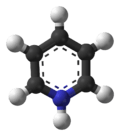Pyridinium chlorochromate
| Pyridinium chlorochromate | |
|---|---|
 | |
 |
 |
| IUPAC name Pyridinium chlorochromate | |
| Other names PCC | |
| Identifiers | |
| CAS number | 26299-14-9 |
| ChemSpider | 10608386 |
| Jmol-3D images | {{#if:O=[Cr](=O)([O-])Cl.[nH+]1ccccc1|Image 1 |
| |
| |
| Properties | |
| Molecular formula | C5H5NHClCrO3 |
| Molar mass | 215.56 g/mol |
| Appearance | orange crystalline powder |
| Melting point | 205 °C; 401 °F; 478 K |
| Solubility in other solvents | soluble in dichloromethane, benzene, diethyl ether, acetone, acetonitrile, THF |
| Hazards | |
| MSDS | external MSDS sheet |
| R-phrases | R49, R8, R43, R50/53 |
| S-phrases | S53, S45, S60, S61 |
| Main hazards | Poison, contact hazard, inhalation hazard, environmental hazard, carcinogenic, irritant |
| NFPA 704 |
 3
3
|
| Except where noted otherwise, data are given for materials in their standard state (at 25 °C (77 °F), 100 kPa) | |
| Infobox references | |
Pyridinium chlorochromate (PCC) is a red–orange salt with the formula C5H5NH[CrO3Cl]. It is a reagent in organic synthesis used primarily for the oxidation of alcohols to form carbonyls. A variety of related compounds are known with similar reactivity. Although no longer widely used, PCC offered the advantage of the selective oxidation of alcohols to aldehydes, whereas many other reagents were less selective.[1] Disadvantages to using PCC are the tedious reaction workup and its toxicity. The chemical was first synthesized and used by discovered by E.J. Corey and J. William Suggs.
Preparation and structure
The original preparation, which was discovered by accident,[2] involves the reaction of pyridine with chromium trioxide and concentrated hydrochloric acid:[3]
- C5H5N + HCl + CrO3 → [C5H5NH][CrO3Cl]
Alternative syntheses have been developed.[4]
The compounds consists of the cation pyridinium ([C5H5NH+]) and the tetrahedral chlorochromate anion (CrO3Cl-). Related salts are also known, such as [C5H5N(C4H9)]+[CrO3Cl]−, 1-butylpyridinium chlorochromate.
Properties and uses
Oxidation of alcohols
PCC is used as an oxidant. In particular, it has proven to be highly effective in oxidizing primary and secondary alcohols to aldehydes and ketones, respectively. Rarely does over-oxidation occur (whether intentionally or accidentally) to form carboxylic acids, unlike the related Jones reagent. A typical PCC oxidation involves addition of the alcohol to a suspension of PCC in dichloromethane.[5][6][7] A sample reaction would be:
- C5H5NHCrO3Cl + R2CHOH → C5H5NHCl + H2CrO3 + R2C=O
In practice the chromium byproduct deposits with pyridine as a sticky black tar, which can complicate workup. Addition of an inert adsorbent such as crushed molecular sieves or silica gel allows the sticky byproduct to adsorb to the surface, and makes workup easier.
Other reactions
In addition to simple oxidations of hydroxyl groups, rearrangements are possible. For example, tertiary alcohols cannot be oxidized directly. However, in the Babler oxidation, the chromate ester formed with PCC and an allylic tertiary alcohol can isomerize via a [3,3]-sigmatropic reaction before the carbonyl-forming oxidation step. Other common oxidants usually lead to simple dehydration rather than any oxidation reaction at tertiary hydroxyl centers.
Another oxidative reaction of PCC is its conversion of unsaturated alcohols or aldehydes to cyclohexenones. This pathway, an oxidative cationic cyclization, is illustrated by the conversion of (−)-citronellol to (−)-pulegone. PCC also effects allylic oxidations, e.g. for the conversion dihydrofurans to the lactones.[1]
Related reagents
Other reagents for oxidizing alcohols using more convenient or less toxic reagents include DMSO-based oxidations (Swern oxidation, Moffatt oxidation) and hypervalent iodine based oxidation (such as the Dess–Martin periodinane).
References
- ↑ 1.0 1.1 Giovanni Piancatelli, Frederick A. Luzzio, "Pyridinium Chlorochromate" Encyclopedia of Reagents for Organic Synthesis, 2007, John Wiley. doi:10.1002/047084289X.rp288.pub2
- ↑ http://pipeline.corante.com/archives/2005/10/11/the_old_stuff.php#44460
- ↑ Corey, E.J.; Suggs, W. (1975). "Pyridinium Chlorochromate. An Efficient Reagent for Oxidation of Primary and Secondary Alcohols to Carbonyl Compounds". Tetrahedron Lett. 16 (31): 2647–2650. doi:10.1016/S0040-4039(00)75204-X.
- ↑ Agarwal, S; Tiwari, H. P.; Sharma, J. P. (1990). "Pyridinium Chlorochromate: an Improved Method for its Synthesis and use of Anhydrous acetic acid as catalyst for oxidation reactions". Tetrahedron 46 (12): 4417–4420. doi:10.1016/S0040-4020(01)86776-4.
- ↑ Paquette, L. A.; Earle, M. J.; Smith, G. F. (1998), "(4R)-(+)-tert-Butyldimethylsiloxy-2-cyclopenten-1-one", Org. Synth.; Coll. Vol. 9: 132
- ↑ Tu, Y.; Frohn, M.; Wang, Z.-X.; Shi, Y. (2003), "Synthesis of 1,2:4,5-Di-‘’O’’-Isopropylidene-D-erythro-2,3-hexodiulo-2,6-pyranose. A highly Enantioselective Ketone Catalyst for Epoxidation", Org. Synth. 80: 1
- ↑ White, J. D.; Grether, U. M.; Lee, C.-S. (2005), "(R)-(+)-3,4-Dimethylcyclohex-2-en-1-one", Org. Synth. 82: 108
Further reading
- G. Tojo and M. Fernâandez (2006). Oxidation of alcohols to aldehydes and ketones : a guide to current common practice. New York: Springer. ISBN 0-387-23607-4.
External links
- IARC Monograph "Chromium and Chromium compounds"
- History of PCC
- National Pollutant Inventory - Chromium VI and compounds fact sheet
| |||||||||||||||||||||||||||